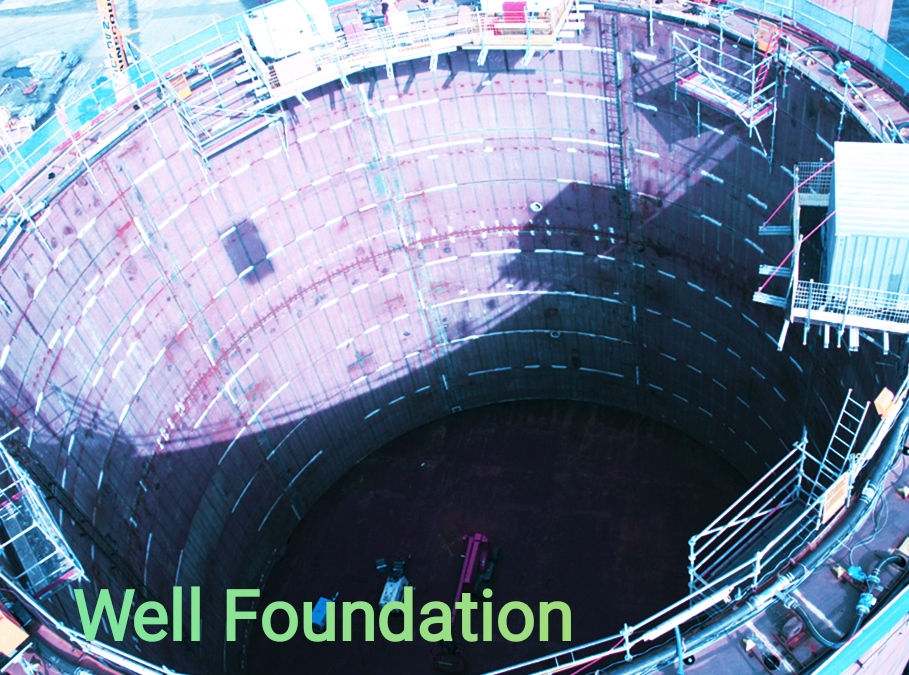Table of Contents
What is Well Foundation?
A well foundation is a type of deep foundation in the form of a hollow prismatic box that is built above ground and lowered as a unit to the required depth.
See the below image of well foundation.

It is like a waterproof chamber used for laying the underwater foundations of monuments, bridges and aqueducts.
Well foundation provide a strong foundation for heavy loads and are useful where loads need to be transferred to deeper layers of soil, such as bridge foundations.
Well foundations are most commonly used as bridges and flyovers. It should withstand large lateral force. This type of foundation is used in various cases as listed below.
- If the river bed is prone to severe rillin.
- If a large amount of floating debris is expected during floods.
- If large rocks are embedded in the base well.
Types of Well Foundations
1. Open Well Foundation:
Drilling continues until the well reaches the required depth/foundation height (RL). During construction, the top and bottom are opened when the well is above ground or at the required depth. The bottom is filled with concrete, called a soil plug, and the dredged holes are filled with sand.
2. Land Well Foundation:
The most common type, assumed to be easy to build when natural land is available for construction.
3. Island Well Foundation:
Similar to Land Wells, but located in deep water, allowing artificial islands to be built and maintained throughout construction time. Normally, it can be used up to a depth of 6m and at a water speed of 1m/s or less.
4. Floating Well Foundation:
This is a special type of well foundation that cannot be built and maintained on the island for the entire construction period.
Components of Well Foundation
1. Well Curb:
The well curb is a well RCC ring beam component with a steel cutter at the bottom. The vertical cross-section of the well end is wedge-shaped, which is useful when drilling wells. The curb supports well staining, and the staining slightly protrudes outward to reduce skin friction during well sinking.
2. Well Steining:
Steining is an RCC wall or shell structure that helps transfer loads to the curb. It serves as an enclosure for excavating the ground to penetrate the foundation firmly.
3. Earth Plug:
After the settlement is complete, fill the base of the foundation shaft with concrete. The rim of the well limits the plug of soil and acts like a raft against the pressure of soil from below.
4. Backfill:
After the plug concrete has set, the well is drained and backfilled with sand or approved drilling material. In some cases water can be used instead of sand/drilling.
5. Top Plug:
This is a concrete layer approximately 500 mm thick specified in the design and drawings. The top of the fill and the top plug of the borehole of the well.
6. Fountain Cover:
The Fountain Cover is a thick concrete mat placed over the top of the fountain. It is part of the foundation and is used to distribute the superstructure load across the stein.
Construction of well foundation
A well foundation is a type of deep foundation traditionally placed below the water level of a bridge. Methods used for well foundation construction and well subsidence include horizontal excavation by divers, grab method, jet air method, jet water method, jackdown method, vertical cutting edge method, and pneumatic caisson method.
Pneumatic caisson technology is mainly used in hilly and rocky areas. A pneumatic caisson is a type of caisson that is closed at the top and exposed at the bottom during construction. Water is expelled from the caisson cell or chamber by compressed air. Pneumatic caissons primarily control the work and preparation of foundations in rocky areas for lowering caissons.
Caissons in the supine position can only be endangered with full observance. The bottom of the cell should be well sealed with concrete, as placing it on dry ground can be dangerous.
Excavation takes place under very high pressure and workers can go inside to inspect the work. This method may have some health hazards. All the above techniques used for good foundation have many advantages and disadvantages.
Advantages of Well Foundation
- Well foundations are able to withstand the effects of scouring due to their large cross-sectional area and high stiffness.
- Well foundations are capable of withstanding large lateral loads and moments encountered in piers, abutments, tall chimneys and towers.
- Since there is no vibration when the well subsides, there is no risk of damaging adjacent structures.
- The well foundation has proven economical for large structures where a suitable base course is only available at very deep locations.
